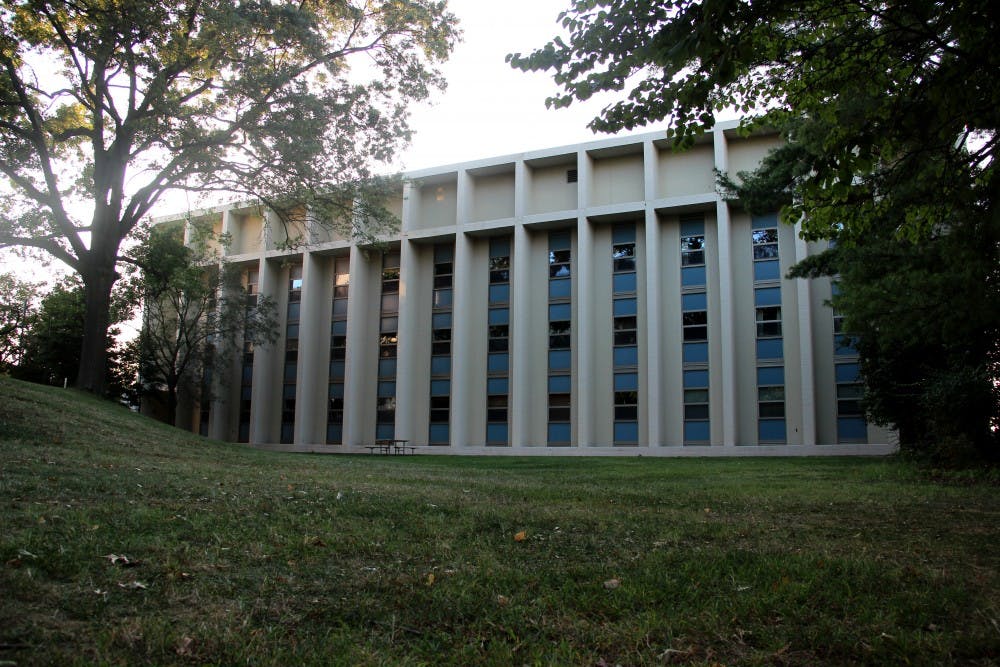Despite the coronavirus outbreak, one of AU's largest construction projects, the Hall of Science, is still active.
For University administrators, faculty members and students alike, the hall could be much more than a new building.
"All three [current science buildings] are 50 plus years old, and science has changed a lot since then," said Peter Starr, dean of the College of Arts and Sciences.
As students and staff within higher education face uncertain times amid the COVID-19 outbreak, campus administrators said they hope the creation of a new building will ensure opportunity for the AU community.
Citing everything from new technology to a newfound sense of school spirit, faculty and staff believe the Hall of Science will rally and excite students. They also hope it will serve as a recruiting tool for new faculty and staff, much like the McKinley Building’s renovation has done over the past decade.
Under development for the previous nine years, and under construction since 2018, the hall will have a total of 95,000 square feet of floor space. The project budget for the building is $90 million, and the University has raised $5 million of it’s $30 million fundraising target, Stacie Burgess, an AU spokesperson, told The Eagle in an email.
Set to open in the fall, the Hall of Science will house classes previously held in the Beeghly Chemistry Building, Hurst Hall and Asbury Hall.
According to Starr, Beeghly, Hurst and Asbury will no longer serve as science facilities for the University. The buildings will be repurposed, but their new roles have yet to be determined.
CAS assistant professor John Bracht believes the new building will serve as a recruitment tool for potential faculty and students.
“Having a place to put [new faculty] opens up great opportunities to expand departments,” Bracht said. “While Hurst Hall has a certain historical value, from a research perspective, the infrastructure can be challenging.”
Bracht recalled that classrooms on the bottom floor of Hurst Hall have flooded multiple times.
The Hall of Science will be three stories and will house collaborative spaces. The building, which is organized into core facilities, will allow students and faculty from different science departments to share technology and work areas.
That means that chemists, biologists, environmental scientists and neuroscientists will share work spaces based on their research and core facilities.
The building will be equipped with new technology, including cameras and screens that will allow students in the back of some lecture halls to better see an experiment taking place at the front of the room.
Stefano Costanzi, an associate professor of chemistry, hopes the new building will provide the opportunity for more computational science classes.
Included in the building’s core facilities will be a dedicated space for computation with computers and workstations provided by the University.
“This is going to be a game changer,” Costanzi said. “It will allow access to a common pool of hardware and software that we didn’t have [in Beeghly].”
The new building will house a lab specifically for computation. Experimental laboratories will be limited to students working with chemicals.
Treasa McDonald, a CAS senior administrative assistant, said the new building will consolidate learning spaces for students.
McDonald said many students take their labs in Hurst but must then travel a mile to AU’s Spring Valley Building for their lectures.
The Hall of Science is not the University’s only recent construction project.
According to David Dower, the University’s assistant vice president of planning and project management, other buildings on campus that have undergone construction in the last 10 years include Cassell Hall, Nebraska Hall, the McKinley Building and the School of International Service building.
SOC professor and AU alumna Jill Olmsted has experienced the University’s campus before and after the renovation of the McKinley Building.
"The high level of work continues despite whether you have old or new facilities,” Olmsted said. “But the excitement that a new building brings with new facilities and new possibilities – that's really something.”
Although a D.C. stay-at-home order was issued in March due to the COVID-19 outbreak, construction projects are still allowed to remain active.
Starr plans to have a certificate of occupancy by the end of June, so the building can be used for the fall semester. The building’s dedication will take place the first weekend of October during All-American Weekend.
While the COVID-19 outbreak did not cease construction of the Hall of Science, it did impact the University’s promotional plans. Starr previously hoped to offer tours of the building during Eagle Summit, which is now being held online.
"We don't have a big football team to rally behind, so we have other things that rally the AU campus,” Olmsted said. "I think [a new building is] a real sense of pride. If you are an Eagle who's graduated, then it's great to have this big beautiful space that you can point to and say, ‘That’s my school.’”





